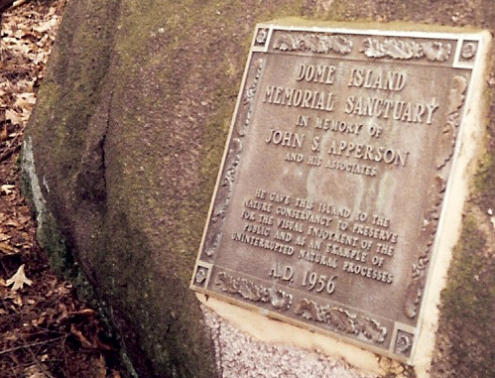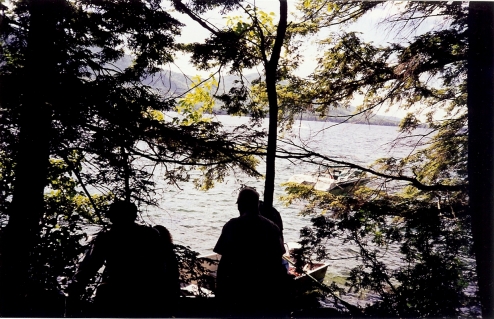
The Dome Island Memorial Sanctuary is designated by a plaque in memory of John S. Apperson.
Recently, I had the chance to interview Ellen Apperson Brown, the great niece of John S. Apperson, the famous preservationist who single-handedly preserved some of Lake George’s most pristine shoreline, including Dome Island. She has been working on his biography and has copies of most of his correspondence.
Below is my interview with her.
To begin, Ms. Brown, you have a website dedicated to your great uncle’s memory and work. Can you tell our readers the address and what they might learn on your site?
I created this website about one year ago, as a way to publish excerpts of letters and other documents that have never been made available to the public. I decided to call it Apperson Associates, since that name suggests that there have been many, many people who believed in the value of Apperson’s work and who became his ardent supporters. So, if you look up www.appersonassociates.com, you will find an assortment of articles written about him (by journalists and historians) and a sampling of his correspondence. Also, there is another website I have created (www.vahistoryexchange.com) with a section devoted to the Apperson family, along with several academic papers I wrote during various graduate programs, describing his childhood and family and giving an overview of his work at Lake George and in the Adirondacks. One other suggestion, for anyone who’d enjoy seeing examples of his early photography, is a Facebook page set up by volunteers a few years ago, at the Adirondack Research Library, in Niskayuna. (see Adirondack Research Library – Facebook).
How is your biography of your uncle coming along? When do you expect it might be published?
I have written several articles over the past year or two that have appeared in such prominent publications as Adirondack Explorer, Adirondack Wild, Adirondack Almanak, the Lake George Mirror, and the New York History Blog. These articles have focused on specific (and colorful) topics: about his “kidnapping” of Governor Al Smith ( in 1923), his leadership in persuading the D & H RR to allow campers to take camping gear on the railroad (1913), and his friendships with some of the “great and gracious,” including George Foster Peabody and William K. Bixby. I plan to keep writing short articles as a way to reach a wide audience. In August I ventured into self-publishing and produced a booklet entitled Back in the Day: How John Apperson formed an early neighborhood association in Huddle Bay at Lake George. Copies are available for purchase ($12.95) at Trees, a gift shop in Bolton Landing, or by contacting me directly (inglesferry@gmail.com).
It is very hard to set aside sufficient time to write a big biography, especially without the support of a fellowship or other grant funding. I hope that Union College (Kelly Adirondack Center) will soon find sufficient funding and will consider inviting me to spend a semester or so to work in the Apperson archives, and to teach students and researchers there about the contents of this very important collection of papers!
The story of Dome Island being preserved is a long one. Can you explain why it was important to your great-uncle and why it is still important today?
Often described as the centerpiece of Lake George, Dome Island was the “jewel in the crown” of all of Apperson’s projects and achievements. Ever since his first excursions to the lake, in the early 1900s, he began wondering how this island could be protected and preserved. He thought of it as the gateway to the islands of the Narrows, and soon began promoting the idea of a Lake George Park. His dream was to bring all of the western (Tongue Mountain) and the eastern (Paradise Bay and Black Mountain Point) shores under state control, but he was frustrated by many factors, including corrupt governmental officials and the desire of several landowners to maintain their holdings for their own exclusive use.
He corresponded with Pliny Sexton, owner of the island, and explained to him why he had gone to the trouble of repairing the shoreline (hauling tons of rocks, and building a wall to protect the soil and trees) at his own expense. Sexton did not seem very interested in the problem, or very appreciative of all the hard work. Apperson sought advice from key wealthy people, hoping they might be able to help him solve the problem. In October of 1917, William K. Bixby offered to be “one of a group of five or six to buy Dome Island if Mr. Sexton does not lease it for the public.” Then Bixby continued, “I should favor giving the island to a board of trustees for the benefit of the Town of Bolton. Establish restrictions. Let the board of trustees be five men of standing and who love Lake George, with power to select their successors.” This wonderful idea did not ever come to pass.
By 1939, Appy noticed with alarm that a contractor was removing trees and appeared to be preparing to build a house or perhaps a hotel, so he sprang into action. He persuaded his close friend and associate, Dr. Irving Langmuir, to loan him some of the money, and they managed to purchase the island for $4,500. This was during the depression, and represented a truly remarkable expenditure, especially by a man whose sole means of support was his salary as an engineer at General Electric.
It took him another 15-16 years to find a suitable, lasting solution, when he gave the island to the care of the Nature Conservancy. Today, at Lake George, we all hear about easements and various legal strategies, allowing landowners to leave their properties (e.g. – to the Lake George Land Conservancy) with restrictions against future development, but in 1956, this was a ground-breaking experiment! Appy was a pioneer!

A view from Dome Island.
Dome Island is closed to the public but there are researchers who are allowed to enter. Can you tell us a little about them?
There is a special Dome Island Committee charged with the responsibility for watching over the island, for conducting various research projects, and for organizing annual events. To understand how this committee was formed, we must go back to the 1950s, when Apperson was struggling to find a permanent solution for Dome Island, having concluded that giving the island to the State of New York might not be a viable option. He eventually made friends with Alvin Whitney, Head of the New York State Museum, and one of the founders of the Nature Conservancy (Eastern New York Chapter), and by 1956 they hatched a plan whereby Apperson would give the island to the fledgling organization, along with an endowment of about $20,000, with the understanding that the island would be protected, in perpetuity. Irving Langmuir and scores of friends made generous contributions to the endowment, and by the time of Appy’s death, in 1963, the Island was being protected by a special group, the Dome Island Committee.
Are there any days when Dome Island can be entered upon?
For anyone who is disappointed to learn that Dome Island is restricted from camping and hiking, they should be reminded that scores of other islands are available for such uses, and that Dome is protected, for good reason, by the covenants of an agreement, signed more than fifty years ago. Several local residents serve on the committee, and have offered me hospitality over the years. About 15 years ago, I went along for the annual visit to the island, riding in a boat owned by Bill White, one of Appy’s most faithful friends, as well as Doug Langdon and Henry Caldwell. For more up-to-date information about what is happening at Dome Island, perhaps Henry Caldwell would be a good source of information…at his store in Bolton, called Black Bass Antiques. Otherwise, I suggest folks might want to contact the Lake George Land Conservancy, where Nancy Williams or someone else on her staff could put you in touch with current members.
So is Dome Island private or public property?
Dome Island is a private nature preserve, protected by a deed of gift established in 1956, and owned by a non-profit land conservancy. There is still a special fund that is dedicated to the island (for repairs and research). The jury is still out as to whether this experiment in environmental preservation will last another fifty to one hundred years, but I believe that my great uncle would be delighted to see how well it has survived, and to know that people are still interested in his efforts to save it!
Can you tell us something that most people do not know about John Apperson?
This question reminds me of the story of the blind men and the elephant. Each of them examined one section of an elephant’s anatomy and concluded that the elephant was…a snake (the trunk), a tree (a leg), a rope (the tail) and so on, but none of them could grasp the overall size or appearance of the beast. Similarly, many scholars have helped collect and pass along stories about John Apperson – about his amazing enthusiasm for hiking, camping, skate-sailing, skiing; about his passion to save the islands at Lake George through a sustained effort to recruit volunteers to rip-rap the shores; of his successful grassroots campaigns to defend the forever wild clause of the NY constitution; and of his gift of Dome Island to the Nature Conservancy…but virtually no scholars have had an opportunity to study the documents that reveal all the details of his methodology and strategic plans.
They don’t know that he was a documentary photographer and film maker, or that he had such a masterful command of the politics of his day. They don’t realize that he had formed important relationships with FDR and Eleanor, with Al Smith, and with George Foster Peabody. And they don’t realize what he sacrificed and endured along the way, making enemies of a long list of conservation commissioners and of the greatest power broker of all time – Robert Moses. In summary, I suppose most people don’t know how ambitious he was, and how successful…in accomplishing his main goal – of creating a Lake George Park.
What are some of the other important aspects of your great uncle’s legacy that you want people on Lake George to know?
He has left us a big challenge, asking us to figure out how to be stewards of the land and water. He fought against greed and self-interest, confronting wealthy land-owners to think about how the beautiful scenery might be enjoyed by future generations, and not developed into great mansions, city lawns, and tacky, Coney Island – style dance halls, motels and amusement parks. He tried to teach everyone to think critically, to get organized, and to make things happen. I hope future generations will become familiar with his life’s work, and carry on his good example!
Ms. Brown – thank you again for your thoughts. Please stop by and visit your “friends” in Huletts Landing some time.
Photos provided by Ms. Brown.
